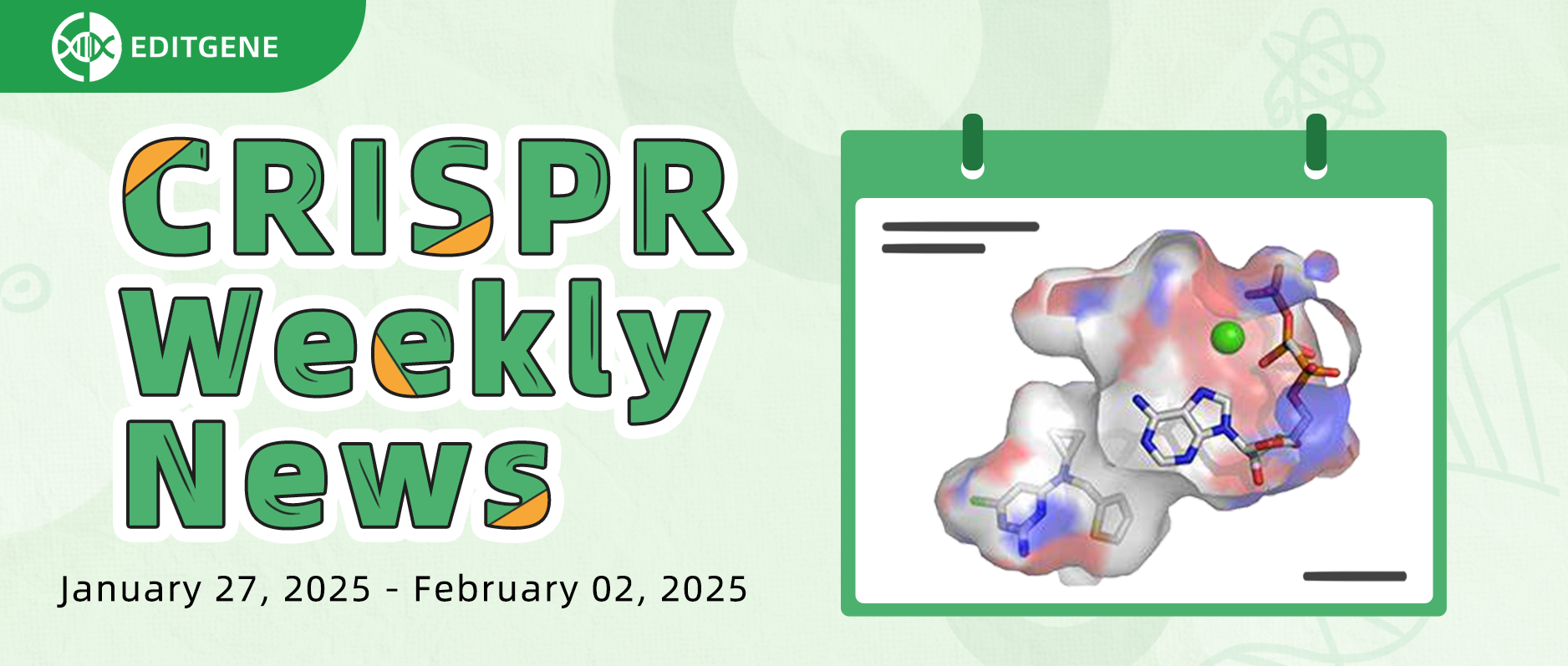New Insights into Type III CRISPR System: Cryo-EM Reveals Selective Synthesis of Cyclic Oligoadenylates (cOA) as a Second Messenger in the System
CRISPR/Cas9

CRISPR/Cas technology is a revolutionary tool in modern biological sciences, with applications spanning medicine, agriculture, environmental conservation, and more. New findings and case studies continue to emerge across these fields. Our‘CRISPR Weekly News’column brings you the latest research and industry updates. Here's a brief summary of the past week's highlights:
I. Research Updates
1. Title: Genome-wide CRISPR-Cas9 screening identifies ITGA8 responsible for abivertinib sensitivity in lung adenocarcinoma
Journal: Acta Pharmacologica Sinica (Impact Factor: 6.9)
Original Link:https://doi.org/10.1038/s41401-024-01451-0
The development of epidermal growth factor receptor tyrosine kinase inhibitors (EGFR-TKIs) has improved the prognosis of certain lung cancer patients with EGFR mutations. However, acquired resistance to EGFR-TKIs poses a significant challenge to treatment. Through a genome-wide CRISPR-Cas9 screening of lung adenocarcinoma cells, researchers from China identified integrin subunit α8 (ITGA8) as a key gene contributing to avitinib sensitivity. Upon further validation, the research team demonstrated that ITGA8 inhibits the proliferation, invasion, and migration of lung adenocarcinoma cells, enhances sensitivity to EGFR-TKIs, improves therapeutic efficacy, and delays the progression of acquired resistance in an H1975 cell xenograft mouse model.
2. Title: SCARB1 links cholesterol metabolism-mediated ferroptosis inhibition to radioresistance in tumor cells
Journal: Journal of Advanced Research (Impact Factor: 11.4)
Original Link:https://doi.org/10.1016/j.jare.2025.01.026
A recent study has unveiled the crucial role of scavenger receptor class B type 1 (SCARB1) in tumor cells, offering new insights into cancer treatment. The research found that SCARB1 significantly inhibits ferroptosis—an iron-dependent form of cell death—by regulating cholesterol metabolism and upregulating coenzyme Q10 (CoQ10). This inhibition not only enhances tumor cell resistance to ferroptosis inducers but also promotes radioresistance. Interestingly, SCARB1 also exhibits an inhibitory effect on tumor growth, migration, and invasion, which may be independent of ferroptosis. Moreover, the study revealed that the combined use of ferroptosis inducers can overcome radioresistance in tumor cells with high SCARB1 expression. These findings provide a novel therapeutic strategy for overcoming radioresistance by targeting lipid metabolism, while also laying a theoretical foundation for the application of ferroptosis in cancer treatment.
1.Title: Programmable DNA Nanoswitch-Regulated Plasmonic CRISPR/Cas12a-Gold Nanostars Reporter Platform for Nucleic Acid and Non-Nucleic Acid Biomarker Analysis Assisted by a Spatial Confinement Effect
Journal: Nano Letters (Impact Factor: 9.6)
Original Link:https://doi.org/10.1021/acs.nanolett.4c05829
To address common challenges in CRISPR-based multiplex biomarker detection, such as the need for multiple crRNAs and insufficient sensitivity, researchers from China have developed a programmable DNA nanoswitch (NS)-regulated plasmonic CRISPR/Cas12a-gold nanostars (Au NST) reporter platform. This system leverages a spatial confinement effect to detect both nucleic acid and non-nucleic acid biomarkers. By embedding target recognition sequences within the NS, they achieved simultaneous detection of nucleic acid and non-nucleic acid biomarkers using only a single crRNA. This method significantly improved sensitivity, reducing the detection limit for miRNA-375 and prostate-specific antigen by 196-fold and 122-fold, respectively. Furthermore, the platform successfully detected the same biomarkers in clinical urine samples, enabling differentiation between prostate cancer patients and non-prostate cancer individuals.
2.Title: Amplification-free detection of Mycobacterium tuberculosis using CRISPR-Cas12a and graphene field-effect transistors
Journal: Nanoscale (Impact Factor: 5.8)
Original Link:https://doi.org/10.1039/D4NR03852E
A research team from Fudan University has recently developed a graphene field-effect transistor (GFET) based on the CRISPR-Cas system for detecting Mycobacterium tuberculosis. By leveraging the specific recognition and cleavage ability of CRISPR-Cas12a, the team integrated this system into an FET platform. Utilizing its electrical signal amplification capability, they achieved rapid and highly sensitive detection without the need for sample pre-amplification, reaching a detection limit as low as 2.42×10-18 M. The study demonstrated that the Cas12a-GFET device could distinguish 30 positive cases from 56 serum samples within just five minutes, highlighting its potential for future bioanalytical applications and clinical diagnostics.
3.Title: Multiplex Digital Nucleic Acid Analysis by a LAMP–Argonaute Coupling Assay via a Parallel Droplet Fusion SlipChip
Journal: Analytical Chemistry (Impact Factor: 6.7)
Original Link:https://doi.org/10.1021/acs.analchem.4c05145
A research team from China has reported the development of a multiplex digital nucleic acid detection method that combines nucleic acid amplification and Argonaute protein (Ago)-specific detection using the parallel droplet fusion technology of SlipChip. The SlipChip generates a series of droplets for multiplex digital loop-mediated isothermal amplification (LAMP), followed by the formation of another set of droplets containing Ago reagents, which are then mixed in parallel for reaction. This process produces three distinct digital fluorescence signals (FAM, ROX, and Cy5), each corresponding to a specific target sequence. The research team successfully conducted viral load analysis for respiratory viruses such as influenza A, influenza B, and SARS-CoV-2 within 60 minutes. Additionally, they applied this assay to analyze viral loads in 34 clinical samples, demonstrating its potential for rapid and high-throughput clinical diagnostics.
iii. Other CRISPR-Related Research
1. Title: Virus-free CRISPR knock-in of a chimeric antigen receptor into KLRC1 generates potent GD2-specific natural killer cells
Journal: Molecular Therapy (Impact Factor: 12.1)
Original Link:https://doi.org/10.1016/j.ymthe.2025.01.024
As an off-the-shelf allogeneic cell therapy, natural killer (NK) cells have attracted significant attention due to their cytotoxic properties. However, their activity against solid tumors remains suboptimal, partly due to the upregulation of NK cell inhibitory ligands, such as HLA-E, in the tumor microenvironment. To address this challenge, researchers from multiple institutions in the United States conducted a study using NK cells isolated from human peripheral blood. They employed a virus-free CRISPR-Cas9 approach to knock a chimeric antigen receptor (CAR) into the KLRC1 gene, which encodes the NKG2A receptor that binds to HLA-E, generating highly potent GD2-specific NK cells. The study reported that genome editing using CRISPR-Cas9 ribonucleoprotein complexes efficiently disrupted the KLRC1 gene with a knockout efficiency of up to 98%. Additionally, the specific knock-in efficiency of the GD2 CAR transgene reached 23%, with minimal off-target effects as confirmed by various sequencing methods.
2. Title: Characterization of the role of spatial proximity of DNA double-strand breaks in the formation of CRISPR-Cas9-induced large structural variations
Journal: Genome Research (Impact Factor: 6.2)
Original Link:https://doi.org/10.1101/gr.278575.123
Structural variations (SVs) play a crucial role in genetic diversity, evolution, and carcinogenesis, making them highly relevant to human health. However, the impact of the spatial proximity of DNA double-strand breaks (DSBs) on SV formation remains unclear. To investigate whether the spatial proximity between two DSBs influences DNA repair, researchers from Denmark analyzed data from 3C-based assays (Hi-C, ChIA-PET, and ChIP-seq) to identify highly interacting sites across six different chromosomes. Using CRISPR-Cas9 nucleases and a pair of single-guide RNAs (sgRNAs) targeting these sites, they induced DSBs in K562 cells and H9 human embryonic stem cells (hESCs). Their findings indicate that the spatial proximity of DSBs is a key predictor of the frequency of large deletions and inversions induced by CRISPR-Cas9 in K562 cells. This discovery provides valuable insights into the formation of SVs in the human genome and has significant implications for CRISPR-Cas9 applications in gene editing and modeling rare SVs.
3. Title: Mechanistic determinants and dynamics of cA6 synthesis in type III CRISPR-Cas effector complexes
Journal: Nucleic Acids Research (Impact Factor: 16.7)
Original Link:https://doi.org/10.1093/nar/gkae1277
Type III CRISPR and CRISPR-associated (Cas) systems (type III CRISPR-Cas systems) utilize guide RNAs to recognize RNA transcripts from foreign genetic elements, triggering the Cas10 subunit of the type III effector complex to produce cyclic oligoadenylate (cOA) second messengers. In a study published in Nucleic Acids Research, researchers from Switzerland provided new insights into the dynamics of cOA synthesis in type III CRISPR-Cas systems. Their findings reveal key determinants of second messenger product selectivity, offering potential new avenues for engineering these systems.
II. Industry News
1. Orna Therapeutics and Shanghai Simnova Biotechnology Co., Ltd. recently announced the expansion of their strategic collaboration, designating B-cell maturation antigen (BCMA) as a target for RNA-based therapeutic development. This partnership reportedly leverages Orna’s groundbreaking circular RNA (oRNA®) technology and Simnova’s expertise in cell therapy to deliver transformative treatments to patients worldwide.
2. CRISPR licensing company ERS Genomics recently announced the launch of a rapid licensing platform to provide small research enterprises and startups with affordable, fast access to the world's largest foundational CRISPR/Cas9 patent portfolio. The Express License is designed for companies with fewer than 15 employees and less than $10 million in funding, enabling them to use CRISPR/Cas9 technology for internal research. This non-exclusive licensing model makes gene editing, screening, and genomics research more accessible and affordable for smaller institutions.
3. Tune Therapeutics recently announced the completion of over $175 million in financing, with lead investors including New Enterprise Associates, Yosemite, Regeneron Ventures, and Hevolution Foundation. The funding is expected to accelerate the development of the company’s existing pipeline, led by TUNE-401, a clinical-stage epigenetic silencer for the treatment of chronic hepatitis B (HBV). Additionally, the funds will support Tune’s ongoing gene, cell, and regenerative therapy programs while advancing its broader mission of harnessing the power and versatility of epigenetic therapies to treat common and chronic diseases.
EDITGENE focuses on CRISPR technology,offering a range of high-quality gene editing services and in vitro diagnostic products. These include but are not limited to:CRISPR Library Screening,Cell Line Engineering,Monoclonal Cell Line Screening,CRISPR Detection. We are committed to providing the most efficient technical services for CRISPR-related,gene function research,in vitro diagnostics,and therapeutic research.
Recent Blogs
2. [Weekly News] Breakthrough in Gene Editing: Overcoming Immunogenicity with Cas Enzyme Mutants
Follow us on social media
Contact us
+ 833-226-3234 (USA Toll-free)
+1-224-345-1927 (USA)
info@editxor.com














Comment (4)